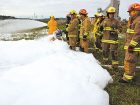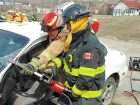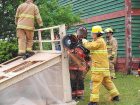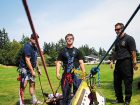
Features
Training
Top-notch teaching
On April 10, 2013, at about 9 a.m., I stood in the frozen mud at the fire training ground in Peace River, Alta., waiting to be fit tested and watching lead instructors Lance Bushie and Rodney Schmidt prepare for evolutions in fire behiaviour and rollover – many, many evolutions.
March 30, 2015
By
Laura King
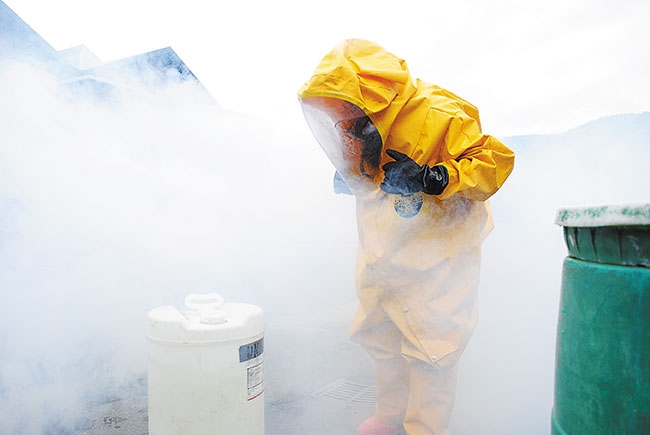 Training in Paradise on Salt Spring Island in British Columbia features 10 courses What makes a great training weekend? Editor Laura King interviews the organizers behind four of Canada’s top training conferences – FireCon
Training in Paradise on Salt Spring Island in British Columbia features 10 courses What makes a great training weekend? Editor Laura King interviews the organizers behind four of Canada’s top training conferences – FireConEight hours later, Bushie and Schmidt were cleaning hoses and preparing for Day 2 – more training with 43 volunteer firefighters from across northern Alberta, and Drager’s Live Fire Training Tour (LiFTT) props and instructors.
Bushie and Schmidt are fire chiefs in Peace River and High Level, respectively – career chiefs of volunteer departments. And, with the help of a committee, they have put together the Northwest Fire Conference, one of the most successful regional firefighter training weekends in Canada.
“It has grown beyond our expectations,” said Schmidt. “The live-fire component – with Drager’s props – and Peace River’s Drager live-fire training centre, offers firefighters training that most of them can’t get at home, from fire behaviour and flashover to RIT, offensive fire attack and vehicle fires.”
The Northwest Fire Conference is one of four model training sessions across Canada run entirely by volunteers and operated primarily for volunteer firefighters who have little access to live fire or any significant hands-on training. FDIC Atlantic in Wolfville, N.S., Training in Paradise on Salt Spring Island, B.C., and FireCon in Thunder Bay, Ont., operate similarly.
What makes a great training weekend? Live fire? Definitely. Good food? Yes. Affordability? For sure. Networking? Absolutely. A mix of hands-on training and classroom sessions? Indeed. A committed team of volunteers who work tirelessly to stage a better-every-year opportunity for firefighters to improve their skills, learn from top-notch instructors and hear world-class presenters? No question.
In 2011, the first year the Nova Scotia Firefighters School mobile burn trailer rolled into the two-day FDIC Atlantic training weekend, firefighters stood around and admired it, as if it were a prized racehorse or an expensive car.
There were only a few timeslots available for training in the trailer and members of the departments that had the foresight to sign up early were chomping at the bit.
“Our main goal at FDIC Atlantic is to be able to provide high calibre speakers without departments having to spend lots of money to travel out of province or country to hear them speak,” said Stephen Fenner, a career firefighter in Halifax and longtime vice-president of FDIC Atlantic.
“This is not even an option for most small departments. Hands-on and live fire training is so important for us to be able to provide in a safe manner. Let’s face it – how cool is it for a small rural department to be able to see flashover and learn how to survive in a controlled environment?”
In Thunder Bay, FireCon organizers are expanding the live-fire training component this year to include Drager’s LiFTT program and will put an ambitious 125 firefighters through evolutions.
“One of the coolest things,” said Thunder Bay Fire Chief John Hay, “is that the whole live-fire training track is going to be run like and incident, so we’ll have the opportunity for senior officers to come and participate in it from an incident-command level.
“Drager is really thrilled about it being run as an incident so incident-management and incident-command principles will be applied to the whole training evolution so they’ll see where the incident safety officer would work and where rapid-intervention facilities would be available and how they would look on the fire ground.”
For Deputy Chief Arjuna George of Salt Spring Island Fire Rescue, Training in Paradise works so well because organizers make sure networking is as significant a part of the weekend as courses.
Back in 2003, George says, he went to a training conference in another part of British Columbia. When sessions ended for the day, everyone dispersed.
“As soon as 4 p.m. hit, it was a ghost town,” George said. “No networking, nothing. We thought, ‘This is crazy, venturing across the province and seeing 30 firefighters here and not getting any value from networking.’
“The following year was first Training in Paradise and we said let’s make sure it’s not just courses and that when people come this far they get a chance to network and understand what other fire departments do across B.C.”
Further, George says, it’s tough enough to retain firefighters when they’re expected to train and train some more, and it’s a lot to ask of families to have firefighters away for a weekend, so the Salt Spring event became a family affair.
“Our own culture at Salt Spring Fire is that family is important . . . so it kind of morphed from our culture at Salt Spring Island Fire Rescue to Training in Paradise.”
While the formats in Wolfville, Thunder Bay, Peace River and Salt Spring Island differ slightly, each event has the same purpose: training, educating and networking – which happens to be the FireCon motto.
People talk about FDIC in Indianapolis. It’s exciting and overwhelming and while there are plenty of HOT sessions and dozens of classroom programs, the four regional training experiences offer substantial bang for the buck (and better beer!) right here at home.
Training in Paradise (TIP) / Justice Institute of BC (JIBC) Regional Training Weekend
Location: Salt Spring Island, B.C.
Website: www.traininginparadise.com
Dates of event: Second weekend in July. For 2015, it is July 9 to 12.
Training facility: Numerous locations, but the main areas are our training ground at hall No. 2 and the Gulf Island Secondary School.
Accommodations: Our four-day weekend offers a great affordable camping option right at the main location for all our social events. The camping is a great networking opportunity and is affordable for most departments.
Organized by: Salt Spring Island Fire Rescue in conjunction with the JIBC.
Sponsored by: Salt Spring Island Fire Rescue, local businesses and trade companies.
Goals/objectives: Our No. 1 goal is to train our members and allow them to train at home, but also to expose our team to others in the fire service and build a strong network of firefighters Canada-wide.
History: Training in Paradise is going into its 11th year; it began with a few members going to other communities to train but never getting the opportunity to network and learn from others outside of class. TIP was born to allow our members to learn and share with firefighters from all over Canada.
Number of delegates/firefighters: Between 80 and120 firefighters each year from across Canada, most from British Columbia.
Number of trainers/instructors: 20
Fee to attend/participate: Varies course by course; JIBC costing for courses. We also include a meal package with each course that provides the students with most meals and a TIP T-shirt.
Hands-on, classroom, or both? Both – recruit frontline firefighter training to officer-level training. We offer an average of 10 classes each year, over four days.
Highlights: Hitting the milestone 10-year mark in 2014. We never expected the weekend to grow and be as successful as it has turned out to be.
What’s different about this event? Definitely the family atmosphere makes TIP stand out. Since the first training weekend we have made sure that the weekend allows for our firefighters and visiting ones to bring their spouses and children and feel welcome. Many of our networking sessions are family oriented; this is unique to most training conferences and allows firefighters to make training without missing out on family time. It’s a win-win!
Best memory: We have an amazing cooking team; in 2014 we tried a hog on the barbecue – it tasted amazing but was also an amazing amount of work as it involved all-night tending.
Most popular courses/programs: It varies every year, but the ones that go toward NFPA fire officer and NFPA firefighter courses seem to fill up first, year after year. Accredited courses seem to attract the most students compared to the workshop-style courses.
One funny story: In the early years of the training weekend the handful of organizers (myself included) ran around like chickens with our heads cut off. We bit off a lot but all that effort brought us to where we are now.
What’s new this year? We have some new and unique courses. Stay tuned to www.traininginparadise.com for details in the coming weeks.
Food: At Training in Paradise there is no shortage of food. Firefighters and good food go hand in hand!
Successful because? Our destination. Our family and kid-friendly weekend events, our course offerings, our social-networking events – every night there is some sort of activity for students and their families.
Entertainment: Varies from live bands to magicians, poker tournaments and extreme bocce.
Sum it up in three words: Training in paradise!
Anything to add? Join us in paradise in July on beautiful Salt Spring Island, or follow the weekend on social media (Facebook and @ssitip).
— Arjuna George is the deputy chief with Salt Spring Island Fire Rescue. He has been involved with Training in Paradise since its inception. ageorge@saltspringfire.com
Northwest Fire Conference (NWFC)
Location: Peace River, Alta.
Website: www.afca.ab.ca or www.prfc.ca
Dates of event: April 29 to May 2, 2015
Training facility: Peace River Fire Department.
Accommodations: Sawridge Hotel and Conference Center, Peace River.
Organized by: Peace Region Fire Chiefs.
Sponsored by: Drager Safety Canada.
Goals/objectives: To provide relevant live training with top speakers to the grassroots firefighter.
History: For 15 years, the NWFC has been providing a regional conference opportunity to firefighters, officers and chiefs from across northwest Alberta. Over the last seven years, the conference has expanded to include world-renowned speakers and live training opportunities. The Drager LiFTT program is now part of the conference, providing volunteer firefighters with live-fire training. This year, we are adding a modern fire behaviour program to teach the latest techniques in fire attack and assessment.
Number of delegates/firefighters: Between 130 and 150 annually.
Number of trainers/instructors: Four to six speakers each year; more than 15 instructors.
Fee to attend/participate: $150 early bird, $200 for members, $275 for non-members.
Hands-on, classroom, or both? Both.
Highlights: This year – modern fire-behaviour tactics with live application in both single-storey and multi-storey facility; learning and using SLICE-RS; speakers Rick Lasky and Richard Gasaway.
What’s different about this event: This program caters to the grassroots firefighter. Using live training facilities with realistic interior fire conditions and instructors from the International Society of Fire Service Instructors (ISFSI), this conference provides the most relevant training available today.
Best memory: As a conference organizer, being able to sit down with Alan Brunacini over supper and just talk. We set up the session room for Brunacini with a lectern and microphone and when he walked in he grabbed a stool, pulled it into the middle of the room with everyone gathered, and just started to talk. Best session ever!
Most popular courses/programs: Without a doubt, the live-fire program. Being able to send firefighters through the exercise – many for the first time as they are from small, volunteer departments – keeps this program very popular. For some, it is the only live training they get each year.
One funny story: I was the lead instructor in the Phase 1 trainer (flashover simulator) and had a group of city firefighters attending. They asked the master instructor what we could teach them and he said, ‘Go and see!’ By the end of the session, they were shaking our hands saying it was the best training they ever had.
What’s new this year? ISFSI modern fire behaviour course, and the SLICE-RS program – for the first time in Canada.
Food: Great. We feed them well!
Successful because? We keep it fresh each year. The live fire training is a steady component but we always add something. We search for the best speakers and keep costs low.
Entertainment: Self-entertainment!
Sum it up in three words: Top notch, always different. (Sorry, that’s four!)
Anything to add? We like to think of our conference as the biggest little show; lots of training, great speakers and lots of support.
— Rodney Schmidt is the fire chief in High Level, Alta., and has been involved with the Northwest Fire Conference since 1999. rschmidt@highlevel.ca
FireCon
Location: Thunder Bay, Ont.
Website: www.oafc.on.ca/event/firecon
Dates of event: Sept. 10 to 12, 2015
Training facility: Live fire – Thunder Bay Fire Rescue Regional Training Centre; classroom – Victoria Inn Hotel and Convention Centre; hands-on training at suitable venues in the area.
Accommodations: Victoria Inn and four other nearby hotels.
Organized by: Emergency North Training Inc., a not-for-profit board, and the FireCon 2015 organizing committee.
Sponsored by: FireCon operated for 25 years with support in many forms from fire departments, fire agencies and fire-service vendors. Core partners since inception include the Office of the Fire Marshal and Emergency Management (OFMEM) and the Ministry of Natural Resources. The Ontario Association of Fire Chiefs has become involved in the delivery of the conference and vendors are playing an increased role in ensuring the quality of presenters. The City of Thunder Bay provides the core live-fire training site.
Goals/objectives: Train – provide quality, standards-based training; Educate – provide knowledge-based education opportunities; Network – provide networking opportunities for all participants through which they can meet other fire-service personnel and exchange knowledge and experiences.
History: Started 25 years ago by those who saw a need to work together to develop quality training opportunities in northwest Ontario. FireCon celebrates its 25th anniversary of meeting and exceeding its goals this year.
Number of delegates/firefighters: Typically about 250.
Number of trainers/instructors: Varies depending on the tracks offered.
Fee to attend/participate: Less than $300 for 2015.
Hands-on, classroom, or both? Mixture of knowledge and practical exercises covering public education, prevention and emergency response.
Highlights: So many it is hard to list, but each year is more successful than the previous.
What’s different about this event? FireCon provides a mix of practical and knowledge-based opportunities and a way for fire-service members, scattered across this vast corner of Ontario, to come together with fire-service agencies and vendors and industry experts to exchange ideas, share knowledge and practise techniques; this ensures the ongoing development of a safer, more effective fire service in northwest Ontario. Holding the event in Thunder Bay, the regional centre, has the added benefit that participants are able to conduct other business and many use FireCon as an opportunity for a family mini holiday.
Best memory: A young woman who was a victim in a serious MVC made a special visit to FireCon 2014 to say thank you to firefighters for saving her life.
Most popular courses/programs: Anything live fire, and hands on. Recent keynote sessions have included fire-service icons such as John Buckman and Dennis Rubin; both have provided some great aha moments for participants.
One funny story: Sitting in a room with 300 firefighters for the Saturday night banquet when the hotel kitchen caught fire and the fire alarms sounded. A very unexcitable group that eventually wound up eating in the adjacent hockey rink. The show went on.
What’s new this year? We are expanding the live fire track through the Drager Live Fire Training Tour (LiFTT) to include 120 students using six evolutions – four evolutions will be available to each student; this will be the largest live-fire program that FireCon and Drager have ever undertaken!
Food: The registration fee includes lunches, closing banquet and sponsored meals.
Successful because? Committed volunteer board, outstanding partnerships, quality and affordable training products and the support of firefighters and communities.
Entertainment: Attendees seem to be able find or create a lot of their own entertainment; at the banquet on Saturday, FireCon always arranges high-quality entertainment to fill the evening, such as a comedian.
Sum it up in three words: Train, educate, network (which is the FireCon brand).
Anything to add? The magic of FireCon is appreciated by all who attend.
— Kenora Fire Chief Warren Brinkman is the president of Emergency North Training Corporation and chairs the FireCon planning committee. wbrinkman@kenora.ca
FDIC Atlantic
Location: Acadia University, Wolfville, N.S.
Website: www.fdic-atlantic.ca
Dates of event: June 5 to 7, 2015
Training facility: Acadia University classrooms and various outdoor locations in Wolfville for hands-on training.
Accommodations: On site in university dorms, included in registration fee.
Organized by: The board of directors of FDIC Atlantic.
Sponsored by: The Nova Scotia Chapter of the International Society of Fire Service Instructors (ISFSI).
Goals/objectives: The Nova Scotia Chapter of the ISFSI is committed to reducing the loss of life, property and damage to the environment by providing quality fire training and education for the fire service in Atlantic Canada through the FDIC Atlantic conference.
History: The Nova Scotia Chapter of the ISFSI is a non-profit, professional association, dedicated to providing training and education to the fire service. We introduced the Fire Department Information Conference (FDIC Atlantic) in 1995. The objective was to provide firefighters in Atlantic Canada with the type of learning experience that had previously required expensive travel, registration and accommodation in Ontario or the United States. Through the generosity of corporate sponsors and our instructors who volunteer their time, we are able to keep costs down and pass these savings along to our participants. FDIC Atlantic has become a focal point for educational seminars directed at emergency responders. Participants come from New Brunswick, Prince Edward Island, Nova Scotia, and Newfoundland and Labrador.
Number of delegates/firefighters: 450
Number of trainers/instructors: 25
Fee to attend/participate: $200-$300 plus HST, depending on registration/accommodation type.
Hands-on, classroom, or both? Both.
Highlights: Big-name keynote speakers and a mix of top-notch instructors from Canada and the United States.
What’s different about this event:
Our directors and instructors all volunteer their time.
Best memory: After the conference is over and I get great feedback, then I know we have made a difference.
Most popular courses/programs: Hands-on sessions and well-known speakers from away.
One funny story: I had to call my wife in Halifax to go pick up a speaker at the airport at the last minute and drive him to Wolfville (an hour or so away) because there was a problem with the rental car. They made it just in time for his class.
What’s new this year? We will be scanning all participants’ name tags for class attendance, and we have some three-hour sessions.
Food: Fantastic – all-you-can-eat cafeteria food.
Successful because? Top-notch speakers and training for the lowest price possible, and all the firefighters who attend.
Entertainment: For 2015, country music artist and paramedic/firefighter Kevin Davidson on the Saturday night at The Axe – the Acadia University pub.
Sum it up in three words: Excellent training opportunity!
Anything to add? I have been doing this conference for the past 18 years and when I see it all come together and we sell out, I look forward to planning for the next one.
— FDIC Atlantic vice-president Stephen Fenner is a career firefighter with Halifax Regional Fire and Emergency. fdicatl@eastlink.ca
Print this page

